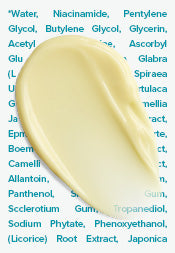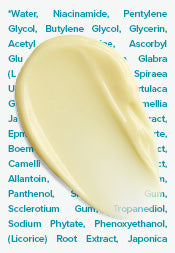How Omega Fatty Acids Help the Skin
Omega fatty acids, like those found in fish and various plant oils, are well known for their remarkable nutritional benefits when consumed via food or supplements as part of a healthy diet — but did you know they also have impactful benefits when applied to skin?
The research about omega’s healthy fatty acids for skin is fascinating; in fact, it inspired us to formulate highly specialised products to deliver these important ingredients — and their benefits — to skin: OMEGA+ Complex Cleansing Balm, OMEGA+ Complex Serum, OMEGA+ Complex Moisturizer, and OMEGA+ Complex Eye Cream. Adding one or more of these omega fatty acid-packed Paula’s Choice skincare products to your skincare routine can supplement and enhance the results you get from your other skincare products for visibly improved skin and a strengthened skin barrier.
What are omega fatty acids?
Omega fatty acids are valuable fats for your diet and your skin. There are 11 omega fatty acids, of which two — omega-3 and omega-6 — are considered essential fatty acids because the body cannot make them on its own. This means that you must supplement them in one way or another. Among the omega fatty acids, the most vital for skin health are:
- Omega-3— Found in foods such as fatty fish, flax seed (linseed) oil, walnut, and chia oils, plus certain species of algae
- Omega-6— Abundant in many non-fragrant plant oils, linoleic acid, and passion fruit oil
- Omega-9— Plentiful in flax seed (linseed) oil and soybean, canola, peanut, and sunflower oils
Omega-3 and 6 fatty acids are not only essential to consume orally, but when applied to skin, research has shown they play a role in maintaining your skin's healthy appearance, among many other benefits. Ready to see just how omega fatty acids support skin health?
How do omega fatty acids benefit skin?
Omega fatty acids are truly remarkable ingredients for skin. They serve as the essential building blocks of skin’s surface layers, creating a smoother, more even, younger-looking, and healthier complexion, no matter your age or skin type. And if the idea of putting fish oil on skin sounds a bit gross, don’t worry — the plant-derived omega-3 fatty acids are just as remarkable for skin!
Here are some of the beneficial ways topical application of omega fatty acids can help skin:
- Reinforce and smooth skin’s surface
- Increase hydration without feeling heavy and help keep skin hydrated
- Calm signs of external stressors, including redness and sensitivity
- Eliminate signs of flaky, dehydrated-looking skin
- Visibly strengthen skin against signs of environmental damage
- Deliver antioxidants to visibly reduce fine lines and wrinkles
All of these benefits mean that applying omega fatty acids to skin leads to visible rewards you’ll love, without bothering with fish oil for skin (keep that for your diet).
Board-certified dermatologist Dr. Corey L. Hartman notes, “Also known lovingly as vitamin L, linoleic acid is one of the most important oils to add to our skin as we are unable to produce it adequately on our own. Not only is it a great way to balance oil and moisture, but it packs an antioxidant punch to increase hydration and calm visible signs of inflammation while improving visible signs of ageing on the surface of the skin. Linoleic and linolenic acids are both underestimated ingredients that need to be discussed more”.
Omegas have a natural affinity for skin and are especially beneficial when combined with other skin-loving ingredients like ceramides, cholesterol, and glycerin. This formulary approach is exactly the path we took with our leave-on OMEGA+ Complex products, all with the same exclusive blend of omega fatty acids.
How to add omega fatty acids to your skincare routine
Whether you're using a basic skincare routine or prefer something more advanced, our OMEGA+ Complex products are easy to incorporate. You can apply one or all once or twice daily, after cleansing, toning, and exfoliating, and then follow with a sunscreen for the face during the day. If you want to start your routine with omega fatty acids, we have an ideal option for all skin types.
Do you need omega fatty acids from multiple products? It depends on your skin’s needs. If you have dry, dehydrated skin showing signs of stress, such as random sensitivity, red patches, and flaky areas, doubling or even tripling up on omega fatty acids is a wise move. You can apply our Omega+ Complex Serum to your face, neck, and chest and then follow with the partner Moisturizer and Eye Cream.
Having trouble deciding which Omega fatty acid staple is right for you? The most significant difference between the Omega+ Complex products is texture: Omega+ Complex Serum is a thin lotion, while OMEGA+ Complex Moisturizer has a whipped cream texture, and OMEGA+ Complex Eye Cream is a lightweight cream. Both the serum and moisturizer contain the same key Omega Complex, but the serum contains a greater concentration.
The moisturizer adds amino acids, some non-fragrant plant oils, and soothing antioxidants, while the serum kicks in Vitamins C and E, incorporates a higher amount of glycerin, and includes plum oil for its omega-9 benefits. The moisturizer relies more on Oleic Acid for omega-9.
The OMEGA+ Complex Eye Cream adds niacinamide, bearberry, mulberry, and liquorice extracts to the mix, which work together to diminish signs of under eye dullness and darkness due to sun damage. Antioxidant Scutellaria baicalensis root contains potent antioxidant compounds, including flavonoids, to help alleviate puffiness by interrupting how external aggressors, like pollution and the sun, impact skin’s surface layers.
These products are designed to layer and are ideal for dry, dehydrated skin. The omega-rich moisturizer and serum are suitable for use around the eyes but consider the eye cream if the skin around your eyes is drier than the rest of your face, or if under eye discolouration is a concern.
Of course, applying a broad-spectrum sunscreen, preferably one that protects skin from UVA and UVB rays, appropriate for your skin type, is an essential part of any morning routine. So, after addressing sensitivity, dryness, and skin barrier strength with Omega fatty acids, apply an SPF 30 or greater.
What if you’re already using one of our serums? Do you need the Omega+ Complex Serum, too? Serums are valuable products because they serve as treatments that can be mixed-and-matched. The ingredients and the benefits from both serums are a plus, but they also have a synergistic effect; that is, when combined, they enhance each other’s benefits. So, there’s no reason not to layer them both in the morning and/or evening. You can also apply one in the morning and the other at night, along with any skin booster treatment or targeted solutions you need. You’ll need to experiment to see what works best for you. Alternating is fine, too. For example, apply one or more omega products every other day, and on the other days, you can apply a different serum and face moisturizer combination.
Each omega product provides anti-ageing, replenishing, and hydrating benefits wherever applied on the face, neck, and chest. The impressive calming properties these formulas have also makes them gentle enough even for eczema- and rosacea-prone skin.
We’re excited for you to see the results from applying omega fatty acids. Research has consistently shown that these acids give your skin essential nutrition, from the outside in.
Learn more about skin restoring ingredients.
Shop fragrance-free, cruelty-free skincare with Omega Fatty Acids.
References for this information:
Nutrients, January 2021, pages 1–31
International Journal of Molecular Sciences, January 2020, ePublication
Marine Drugs, August 2018, ePublication
Biochimica et Biophysica Acta, September 2017, pages 1,679-1,689
Journal of Clinical Medicine, February 2016, ePublication
Brazilian Archive of Biology and Technology, January-February 2012, pages 127–134
Experimental Dermatology, July 2011, pages 537–543
Journal of Agricultural and Food Chemistry, October 2010, pages 112–118
Clinics in Dermatology, July-August 2010, pages 440–451
Annals of Dermatology, May 2010, pages 143–148
https://lpi.oregonstate.edu/mic/health-disease/skin-health/essential-fatty-acids#functions












